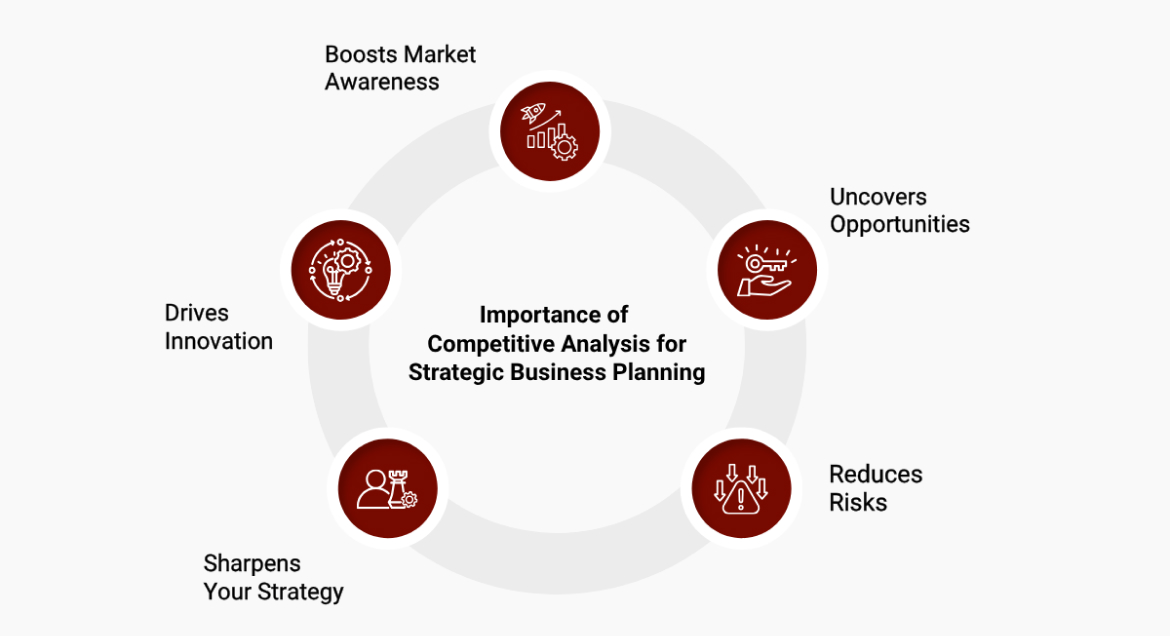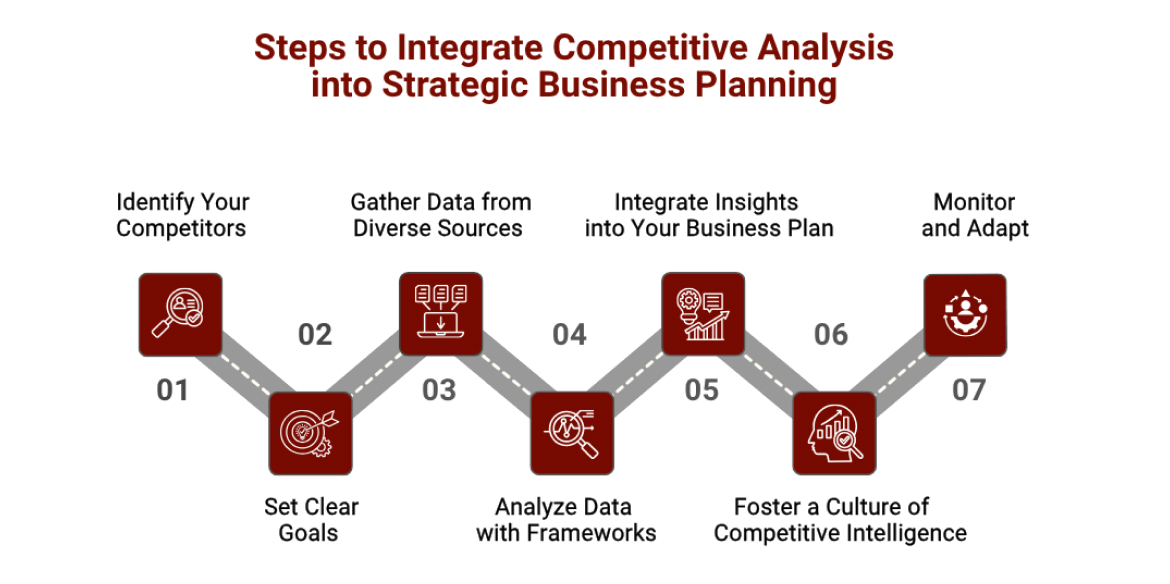Launching a business without understanding your competitors is like sailing without a map—you might get somewhere, but it’s risky. Competitive analysis is a powerful tool that helps you understand your rivals, spot opportunities, and avoid threats. By weaving it into strategic business planning, you can create a business strategy that keeps you ahead in the market. Whether you’re a startup founder, a data engineer managing AI-driven insights, or a business owner refining your plan, this guide will show you how to integrate competitive analysis into your business planning process for success.
In this article, we’ll explore what competitive analysis is, why it’s essential for strategic business planning, and practical steps to incorporate it into your business plan. We’ll also cover key frameworks to make your business strategy robust and adaptable. Let’s get started!
Competitive analysis is the process of studying your competitors to understand their strengths, weaknesses, strategies, and market position. It’s like doing homework on your rivals to see what they’re doing well and where they’re falling short. This insight helps you position your business better, find gaps in the market, and plan smarter.
For example, a coffee shop might analyze a rival’s menu, pricing, and customer reviews to discover that they lack vegan options. This gap becomes an opportunity to attract vegan customers with a unique offering. In business planning, competitive analysis ensures your business strategy is informed by real market dynamics, not guesswork.
Strategic business planning is about setting goals, identifying opportunities, and building a roadmap for growth. Competitive analysis makes this process stronger by providing data-driven insights. Here’s why it matters:

1. Boosts Market Awareness
Understanding competitors keeps you updated on industry trends and customer preferences. For instance, if a rival launches a new AI-powered app, it signals a trend toward tech-driven solutions. This awareness helps you adapt your business strategy to stay relevant.
2. Uncovers Opportunities
By spotting competitors’ weaknesses or ignored market segments, you can find untapped potential. A software company might notice rivals lack affordable plans for small businesses, opening a chance to target that niche.
3. Reduces Risks
Knowing competitors’ moves helps you prepare for challenges. If a rival plans a big marketing campaign, you can counter with promotions or improved services, protecting your market share.
4. Sharpens Your Strategy
Competitive analysis reveals what works in the market. If competitors succeed with social media ads, you can refine your marketing to compete effectively, ensuring your business plan is aligned with customer expectations.
5. Drives Innovation
Studying competitors’ products can inspire new ideas. A retailer seeing rivals offer same-day delivery might invest in logistics to match or exceed that standard, enhancing their business strategy.
For data engineers, competitive analysis can guide AI model development, ensuring tools like recommendation systems or pricing algorithms outperform rivals. Integrating this into business planning makes your business strategy proactive and resilient.
Incorporating competitive analysis into business planning offers clear advantages:
These benefits ensure your strategic business planning is grounded in reality, helping you build a business strategy that drives growth.
To make competitive analysis effective, use structured frameworks. These tools organize data and provide clear insights for business planning. Here are the top frameworks to consider:
1. SWOT Analysis
SWOT (Strengths, Weaknesses, Opportunities, Threats) is a simple yet powerful tool. It evaluates your business and competitors across four areas:
Example: A tech startup finds a competitor’s app lacks AI features (weakness), presenting an opportunity to develop an AI-powered version.
How to Use in Business Planning: Update your SWOT regularly to reflect competitor insights, guiding your business strategy toward opportunities and away from threats.
2. Porter’s Five Forces
This framework analyzes industry competition through five factors:
Example: An electric vehicle startup uses Porter’s Five Forces to assess high supplier power (battery makers), prompting a business plan to secure long-term contracts.
How to Use in Business Planning: Address each force in your business strategy to reduce competitive pressure and boost profitability.
3. PESTEL Analysis
PEST or PESTEL (Political, Economic, Social, Technological, Environmental, Legal) examines external factors affecting your industry:
Example: A fashion brand sees a social trend toward eco-friendly clothing, leading to a business plan focused on sustainable materials.
How to Use in Business Planning: Incorporate PESTEL insights to make your business strategy adaptable to macro trends.
4. Competitor Benchmarking
Benchmarking compares your performance to competitors’ in areas like:
Example: An e-commerce site benchmarks a rival’s fast checkout process, inspiring a business plan to streamline its own.
How to Use in Business Planning: Set goals based on benchmarking data to improve operations and customer experience.
5. Strategic Group Analysis
This identifies clusters of competitors with similar strategies (e.g., low-cost vs. premium). It helps you position your business uniquely.
Example: A SaaS company finds most rivals target large firms, so it focuses on small businesses, shaping its business strategy.
How to Use in Business Planning: Define your strategic group and differentiate within it to stand out.
6. Value Chain Analysis
Value Chain Analysis examines activities (e.g., production, marketing, support) to see where you add value compared to competitors.
Example: A restaurant finds rivals have slow delivery, so it invests in logistics for faster service, enhancing its business plan.
How to Use in Business Planning: Optimize value chain activities to create a unique selling point.
These frameworks make competitive analysis actionable, ensuring your strategic business planning is thorough and effective.
To weave competitive analysis into your business planning, follow these practical steps:

Step 1: Identify Your Competitors
Start by listing primary competitors (direct rivals offering similar products) and secondary competitors (potential entrants or innovators). Use market research, industry reports, or AI tools like PrometAI to spot key players.
Example: A fitness app identifies direct rivals like Strava and secondary competitors like wearable device apps.
Pro Tip: Monitor startups, as they can disrupt markets with innovative solutions.
Step 2: Set Clear Goals
Define what you want to learn. Are you studying competitors’ pricing, features, or marketing? Align goals with your business strategy (e.g., entering a new market, improving products).
Example: A software firm aims to understand rivals’ AI features to enhance its own offerings.
Pro Tip: Focus on 2-3 objectives to keep research manageable.
Step 3: Gather Data from Diverse Sources
Collect information using:
Example: An e-commerce site benchmarks a rival’s fast checkout process, inspiring a business plan to streamline its own.
Pro Tip: Use Docker to deploy AI analysis tools consistently across teams, ensuring reliable data pipelines.
Step 4: Analyze Data with Frameworks
Apply frameworks like SWOT or Porter’s Five Forces to organize insights. Look for patterns, such as competitors’ weak customer support or strong pricing strategies.
Example: A hotel chain uses SWOT to find a rival’s weak online booking system, planning to invest in a better platform.
Pro Tip: Combine multiple frameworks for a fuller picture.
Step 5: Integrate Insights into Your Business Plan
Use insights to shape your business strategy:
Example: A SaaS company learns rivals lack mobile apps, so its business plan prioritizes mobile development.
Pro Tip: Document insights in your business plan for easy reference.
Step 6: Foster a Culture of Competitive Intelligence
Make competitive analysis ongoing by:
Example: A tech firm holds quarterly workshops to review competitor moves, updating its business strategy.
Pro Tip: Reward employees for valuable competitor insights to build engagement.
Step 7: Monitor and Adapt
Markets change, so revisit competitive analysis regularly (quarterly or annually). Use real-time data from AI platforms to stay agile.
Example: A fashion brand tracks rivals’ sustainability efforts, adapting its business plan to include eco-friendly lines.
Pro Tip: Schedule reviews to align with major business planning cycles.
Competitive analysis isn’t always easy. Common challenges include:
For data engineers, deploying AI tools in Docker ensures consistent, efficient data processing, overcoming technical hurdles in large-scale analysis.
To measure success, track:
Example: A retailer sees a 10% sales boost after adopting a rival’s pricing strategy, validating its competitive analysis.
Pro Tip: Compare metrics before and after implementing insights to quantify impact.
The future of competitive analysis is exciting, driven by:
For data engineers, integrating AI models into strategic business planning will require scalable pipelines, where Docker shines for deployment consistency.
Competitive analysis is a game-changer for strategic business planning. By understanding competitors’ strengths, weaknesses, and market trends, you can craft a business strategy that drives growth and resilience. Frameworks like SWOT, Porter’s Five Forces, and PESTEL make insights actionable, while AI tools like PrometAI automate the process for speed and accuracy. For data engineers, Docker ensures consistent deployment of analysis pipelines, enhancing business planning efficiency.

CredBadge™ is a proprietary, secure, digital badging platform that provides for seamless authentication and verification of credentials across digital media worldwide.
CredBadge™ powered credentials ensure that professionals can showcase and verify their qualifications and credentials across all digital platforms, and at any time, across the planet.

Keep yourself informed on the latest updates and information about business strategy by subscribing to our newsletter.